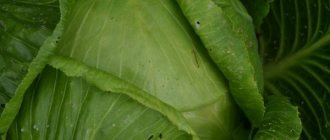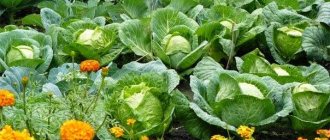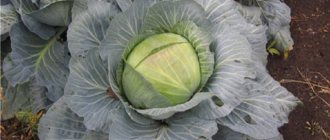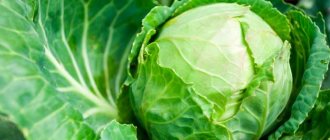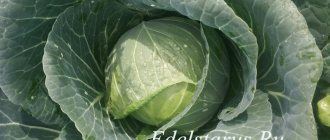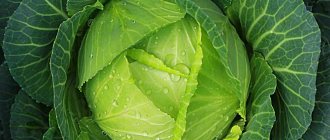A popular, high-yielding hybrid of white cabbage with excellent taste and appearance, loved by many gardeners and farmers - all this is Krautman F1 cabbage. Its description is based only on a list of advantages, since this cabbage has practically no disadvantages.
The hybrid is included in the State Register for many regions of Russia, Ukraine and Moldova. It is grown even in the Far East and East Siberian regions. It is the best in all indicators in the mid-late group of cabbage of Dutch selection.
When growing Krautman F1 you can always count on a full harvest. You just need to follow the basic norms and rules of crop care. You can get vegetable products already 120-140 days after the first shoots.
Description
The leaf rosette of Krautman F1 cabbage is raised and compact. The leaves are medium in size. They have a rich waxy coating and green color. There is wrinkling on the leaves. The edges are smooth and even.
A ripe head of cabbage has a round shape. It is dense, with a thin internal structure, semi-closed. The weight of individual specimens can be from 1.5 to 4 kg. When cut, the head of cabbage is snow-white. The outer and inner stalks are the same length, medium size. The forks are level and resistant to cracking.
High-yielding hybrid Aggressor F1
White cabbage hybrid Aggressor is a mid-late crop. It stores well and gives an excellent harvest. Read more…
The purpose of cabbage is to use it fresh, canning, pickling and pickling.
Subject to simple conditions and growing rules, from each square. m you can harvest up to 9 kg of crop.
You can store collected vegetables for up to 4 months. During this time, they do not lose their taste and presentation.
Advantages and disadvantages
Krautman's description of cabbage implies a listing of all the positive and negative qualities of the product.
Compared to other varieties of mid-season white cabbage, the hybrid has its advantages:
- The main advantage of Krautman F1 cabbage is considered to be its high content of vitamins A and C, minerals and nutrients. According to these indicators, the variety is superior to cauliflower.
- Heads of cabbage can remain on the root for a long time without cracking. They are also not subject to rotting.
- The leaves of the hybrid are crispy and very juicy.
- The vegetable easily tolerates transportation.
- Krautman is not susceptible to diseases and is resistant to various pests. Even the keel is not afraid of him.
- Cabbage has excellent pickling qualities.
- The variety can be used for pickling. The product has a pleasant acidic taste.
- Friendly and timely delivery of the harvest simplifies the process of harvesting and preparing for storage.
- It is possible to achieve a high yield even in bad weather conditions and sudden temperature changes.
- Excellent external data allows you to successfully sell the product on the market.
Experienced vegetable growers note that the heads of cabbage of this variety are very dense, but the leaves are not coarse, but soft and juicy.
The hybrid is quite flexible. Gives good results in various regions. It can even withstand dense plantings.
The heads of cabbage of this hybrid are aligned in size, which is convenient for transportation. Such compact specimens are convenient to grow, collect and send for sale. They are in demand among consumers.
Among the disadvantages in the description of Krautman cabbage, one can note the short shelf life of collected vegetables (maximum 4-5 months). But all mid-season cabbage varieties cannot boast of this indicator.
The hybrid is also demanding on certain growing conditions. In order for a plant to form a powerful root system, it is necessary to carry out a number of actions: proper watering, hilling, loosening and weeding. Cabbage must be fed with mineral fertilizers. Provide a sunny, unshaded area that is well ventilated. Seedlings should not be allowed to be pulled out.
Sometimes there is a slight infection by mucous bacteriosis.
Care
Experienced gardeners know that cabbage is one of the most moisture-loving crops.
Therefore, you need to make sure that it receives enough moisture. If it doesn’t rain at least a couple of times a week, you’ll have to take the watering into your own hands. You need to water once every two to three days, and quite generously - 10-12 liters of water are needed per square meter. In the first days after planting, you can water not with water, but with a weak solution of potassium permanganate, which allows you to destroy the infection in the soil. In order for cabbage to acquire a powerful root system, it is very important to loosen the soil, enriching it with oxygen. To do this, the earth is loosened with a hoe to a depth of 4-5 centimeters
You can also carry out hilling a couple of times a season. A mound of earth filled with soil leads to the appearance of new roots and, as a result, an increase in the size of the fruit.
Don’t forget about fertilizing, especially on depleted soils. It is advisable to apply fertilizer at least twice a season. For the first time - 15-20 days after planting in the ground. In the second - after another 20 days.
It is best to use diluted mullein as fertilizer. To prepare it, fresh cow dung is mixed with water in a ratio of one to eight. The resulting solution should be left to steep for several days, after which the cabbage should be watered at the rate of 500 milliliters per plant.
Secrets of cultivation
When growing Krautman F1 cabbage, the seedling method is used. Sowing seeds for seedlings can be done in early April. They should be deepened into the ground by 0.5-1 cm. Shoots may appear as early as 5-6 days. The plant needs to be planted in open ground at the end of May, usually on the 40-45th day. By this time, the seedlings have several true leaves. The best scheme for growing cabbage is 50×50. Before transferring seedlings to a permanent place, it is necessary to carry out hardening procedures. Leave plants outside during the day. The seedlings also need to be fed. Apply the first fertilizing when two leaves appear, the second immediately before planting.
The variety produces a good harvest on loamy, fertile soils. Cabbage cannot be cultivated in the same areas for another 3 years. The best predecessors are legumes and pumpkins.
How to care
The first time watering is carried out using a slightly pink solution of pharmaceutical potassium permanganate. And further irrigation is performed once a week. Approximately 12 liters of liquid will be consumed per 1 m2. Watering cabbage during the post-precipitation period and during head formation is very important.
Feeding
After 3 weeks from the moment of planting the seedlings, it is necessary to apply the first fertilizing. For these purposes, a solution of mullein is used.
To prepare it, you need to take 1 kg of fertilizer and 10 liters of water. Perform the same fertilizing after 14 days. For cabbage, the use of wood ash will be an excellent fertilizer and pest prevention. Use it to dust. 250 g of ash will be needed per 1 m2.
Loosening and weeding
These events are extremely important for the full growth and development of seedlings. Thanks to loosening, it is possible to saturate the root system of the plant with oxygen and moisture. Perform this procedure carefully and not deeply, so as not to damage the roots. Loosening should always be carried out after watering or frequent rains, avoiding the formation of a crust. But how to care for broccoli, and what are the best varieties for Siberia, is indicated
The video shows the process of loosening cabbage:
Diseases and pests
Krautman cabbage can be affected by various ailments and parasites throughout the growing season. In order to detect a defect in time and eliminate it, you need to know what misfortunes to expect:
- Blackleg. This fungal disease can be identified by how the affected area turns black, becomes thinner and rots. The plant can be removed from the soil very easily. To combat the disease, it is necessary to treat the lesion with 1% Bordeaux mixture, a solution of copper sulfate (10 liters of water and 5 g of the product). All affected plants should be removed and burned. Black leg of cabbage
- Kila. With such a defeat, the bushes stop growing, and their leaves turn yellow and wither. To prevent the development of this disease, wood ash will have to be added to the soil. Kila
- Cruciferous flea beetle. Holes form on the surface of the leaves, which can cause them to die. To eliminate the pest, you will have to treat the plant with an infusion of chamomile, tobacco or garlic. But what the stone head cabbage looks like is described in this video. Cruciferous flea beetle on cabbage
- Cabbage fly. The plant begins to grow very slowly, its leaves fade and become lilac-purple. To combat the disease, you need to treat the plant with burdock infusion. But remove the larvae yourself. It will also be useful to know what the Transfer cabbage variety looks like. Cabbage fly
- Cabbage whites. It gnaws the foliage and can reach the inside of the heads of cabbage. To protect the plant from the parasite, it is necessary to plant it with crops such as tomato, garlic and dill. Remove pest larvae yourself. But this article will help you understand what Lennox cabbage looks like and how difficult it is to grow it. Cabbage whites
Reviews about Krautman
This hybrid of Dutch selection appeared in the Russian Federation not long ago. But during this time, many farm owners and amateur summer residents have already fallen in love with it. Therefore, reviews of the Krautman hybrid can only be found laudatory.
Antonina Arkadievna, Tobolsk
I have been growing Krautman for several years in a row. I don’t know of a more problem-free cabbage. Grows well. The heads of cabbage are pouring to perfection. All are plump and even. It’s nice to look at them both in the garden and in the basement. Cabbage stores wonderfully. I'm cleaning it up in October. I make a little sauerkraut every month. Very tasty in fresh salads. All in all. I have already recommended Krautman to all my friends, and I know that they are only thanking me for the advice.
Heinrich, Tolyatti
Krautman is a great variety. Consider it growing on its own. Does not crack from rain or drought. If the weather is bad, small heads of cabbage may appear. But if you consider that I grow only for my family, and give a little to my children, then the size of the heads of cabbage doesn’t really bother me. The main thing is that it grows and forms dense forks, and the rest is nonsense. But you don’t have to poison cabbage every 2 weeks from various misfortunes.
Angelina Pavlovna, Cherkassy
Not bad Krautman cabbage. But I like Aggressor better. It lasts longer, and they grow almost the same. But in second place for me personally is Krautman.
Summary table of hybrid characteristics
| Variety or hybrid | hybrid |
| Ripening time | mid-season |
| Kochan | round, dense |
| Kocheryzhka | short |
| Disease resistance | high resistance to diseases and pests |
| Fruit weight, g | 1500-4000 |
| Growing areas | the entire territory of the Russian Federation, as well as Ukraine, Kazakhstan and many other countries |
| Disembarkation scheme | 50cm x 50cm |
| From germination to ripeness | 120-140 days |
| Seed placement depth | 0.5-1.0 cm |
| Seedling age | 40-45 days |
| Soil temperature for planting seeds/seedlings | +4/+12 |
| Advantages | Uniformity, uniform yield, resistance to cracking, good transportability, excellent commercial qualities, not afraid of thickening |
| Flaws | needs feeding, is light-loving and moisture-loving |
Features of agricultural technology
Sowing seeds: timing and rules
Seeds are planted in soil poured into wooden boxes or other containers in early April. Grooves are made in the soil. The seeds are buried in them by 10 mm, the distance is maintained at about 30 mm.
The planted material is sprinkled with earth, watered and compacted (lightly). Cover the box with plastic wrap.
On the 6th (sometimes 5) day the first shoots will appear. Picking is done after the formation of two leaves. Then the seedlings are placed in pots.
A few weeks before the planned transplantation of cabbage into open ground, the plants are hardened off. The pots are taken outside for a while each day to acclimate to the wind and natural light.
Planting seedlings in the ground
It is recommended to transplant seedlings into open soil in late May. Planting pattern - 50x50 cm. It is optimal to grow Krautman on fertile loamy lands that previously contained legumes or pumpkin crops.
Small holes are prepared in the ground and filled with water. The roots of the seedlings are lowered into the soil, sprinkled, the earth is compacted and watered. For the first 3–5 days, it is advisable to shade the seedlings so that the sun's rays cannot negatively affect fragile plants.
Caring for Krautman cabbage
The hybrid loves moisture. Therefore, it should be watered regularly. For the first time, the soil is irrigated with water with potassium permanganate added to it (you should get a weak solution with a slightly pink tint).
Subsequently, watering is carried out in the evening or in the morning with settled warm liquid every few days. For 1 square of crops, 12 liters of water are needed. Watering is made more intense when tying cabbage heads.
The hybrid needs fertilizing, which significantly increases productivity. The first is performed 15–20 days after transplanting the seedlings. The second one is made after another 3 weeks.
Mullein plant
For the first feeding, use an infusion of mullein (for 1 part take 8 parts of water) or bird droppings (1 to 12). Each seedling requires about 500 mg of the prepared solution.
Similar infusions are used for the second feeding. But in this case, you need to fertilize the cabbage with a large amount of the mixture (1 l).
High-quality plant care involves spraying its leaves with a special mixture (the procedure is called foliar feeding). For 10 liters of water take:
- superphosphate – 4 g;
- urea – 60 g;
- vitamin C – 1 g.
The leaves are treated with this solution every three weeks. Starting from the third feeding, 20–30% less urea is added to the water.
Full development and growth of seedlings is impossible without periodic loosening of the soil. This simple operation provides the cabbage roots with moisture and oxygen.
Loosening is carried out to a depth of 5 cm with a hoe. At the same time, weeds are removed. If desired, you can lay a layer of peat on the loosened soil, which will eliminate the risk of the reappearance of foreign grass.
Hilling should be done twice a season. The procedure allows the hybrid to sprout additional fresh roots. Through them, more nutrients will reach the crop.
Protecting crops from diseases
During the growing process, Krautman can be affected by parasites and diseases inherent in all varieties of white cabbage. The hybrid suffers from:
- Cabbage fly. Symptoms of the disease are wilting of the leaves, the appearance of purple and lilac spots on them. The fight against the scourge is to remove the larvae manually, and treat the crops with burdock infusion.
- Black leg. The infected part of the plant begins to rot. Solutions of vitriol (5 g of product plus 10 liters of clean water) and Bordeaux mixture (1 percent) can cope with the problem. They treat the lesion. Before this, the diseased seedling is pulled out of the ground.
- Cruciferous flea beetle. Symptoms are the appearance of holes on the surface of the leaves. You can get rid of flea beetles by spraying an infusion of garlic, tobacco, or regular chamomile over the plant.
- Keelas. The disease manifests itself by wilting and falling of cabbage leaves and the subsequent cessation of growth of the latter. Protection against clubroot - fertilizing the soil with wood ash.
Cabbage fly
Harvest time and storage of heads of cabbage
Cabbage becomes technically ripe 120–140 days after the first shoots. From 1 square meter of land, up to 9 kg of crop is collected.
The longest shelf life of a vegetable without additional processing is 4–5 months. The variety is suitable for salting and pickling.
By following simple standards for planting and caring for the Krautman hybrid, any amateur gardener is able to provide himself and his family with fresh and sauerkraut, rich in vitamins and elements important for humans, until the next harvest.


